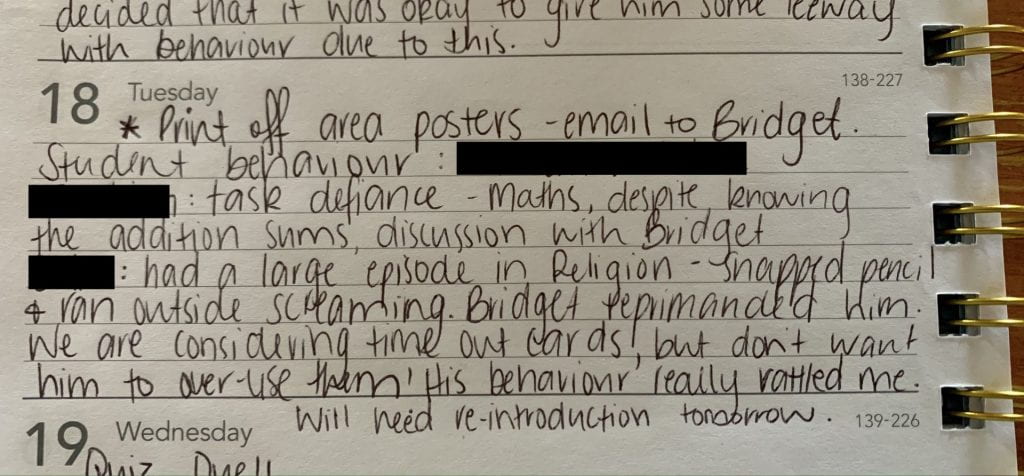6.2 Engage in professional learning and improve practice
6.3 Engage with colleagues and improve practice
Whilst undertaking professional experience at the rural Catholic Primary School, in my Years 3-6 class there was a young student diagnosed with Autism Spectrum Disorder (ASD). Despite being in Year 3, the student was achieving a prep-Year 1 level for both literacy and numeracy, indicating that I was going to need a variety of pedagogical teaching strategies to improve my inclusive practices (6.2). In order to effectively interact with and teach this student, I was aware that I needed to engage in professional learning and also seek guidance from my colleagues to best assist his pathway to success (6.2, 6.3) (Australian Curriculum, Assessment and Reporting Authority, n.d.).
After observing the student with ASD during classroom and lunchtime interactions, I engaged in a plethora of online research to better understand the his characteristics as well as looking at potential strategies or pedagogical approaches to implement during my placement (6.2). Due to never teaching a student with ASD before, I found his behaviour quite difficult to manage and I was eager to improve my practice to better assist him in class (Artefact 1). I examined literature and made a list of approaches from reading Stokes et al (2017), Crosland & Dunlap (2012) and Boutot (2017) to add to my repertoire. For example, a few simple changes to my practice to accommodate this student was giving manageable, concise and repeated instructions, setting clear boundaries and expectations, using visual aides where possible, and my supervisor and I ensured he had a safe withdrawal area that he could go to if he recognised he needed it (Churchill et al, 2019; Stokes et al, 2017; Crosland & Dunlap, 2012; Boutot, 2017). Furthermore, I had multiple conversations and critical reflections with my supervising teacher to determine the antecedent to when he exhibited challenging behaviour or task avoidance (6.3) (Lavan, 2018).
As a result of analysing my practice and engaging in professional learning to best support the child with ASD during placement, I noticed that the small changes I implemented assisted in better on task behaviour from the student (6.2). However I now recognise that it would have greatly benefitted my practice if I had explicitly documented those changes in my diary, as opposed to the minimal notes I took down. In demonstrating APST (6.3) by engaging with colleagues to improve my knowledge, my supervising teacher recognised this and made mention of it in my final report saying, “Susie always sought ways to improve her teaching and reflected on her lessons. She was open to discussions regarding her teaching and always enacted feedback given.” As a beginning teacher, I am eager to seek out and participate in any professional development opportunities available that will assist me to improve my practice and deliver high quality content and experiences to each of my students (6.2, 6.3).

References
Australian Curriculum, Assessment and Reporting Authority (ACARA). (n.d.). Literacy. Australian Curriculum. Retrieved September 18, 2021, from https://www.australiancurriculum.edu.au/f-10-curriculum/general-capabilities/literacy/
Boutot, A. (2017). Autism spectrum disorders: Foundations, characteristics, and effective strategies (2nd ed.). Pearson.
Churchill, R., Godhino, S., Johnson, N., Keddie, A., Letts, W., Lowe, K., Mackay, J., McGill, M., Moss, J., Nagel, M., Shaw, K., & Rogers, J. (2019). Teaching: Making a Difference (4th ed.). John Wiley & Sons Australia.
Crosland, K., & Dunlap, G. (2012). Effective strategies for the inclusion of children with autism in general education classrooms. Behavior Modification 36(3), 251–269. https://journals-sagepub-com.ezproxy.usq.edu.au/doi/pdf/10.1177/0145445512442682
Lavan, G. (2018). Managing challenging behaviour in the classroom: A framework for teachers and SENCOs. Routledge. https://ebookcentral-proquest-com.ezproxy.usq.edu.au/lib/usq/reader.action?docID=4930794
Stokes, M., Thomson, M., Macmillan, C., Pecora, L., Dymond, S., & Donaldson, E. (2017). Principals’ and teachers’ reports of successful teaching strategies with children with high-functioning autism spectrum disorder. Canadian Journal of School Psychology, 32(3-4), 192–208. https://journals-sagepub-com.ezproxy.usq.edu.au/doi/pdf/10.1177/0829573516672969
